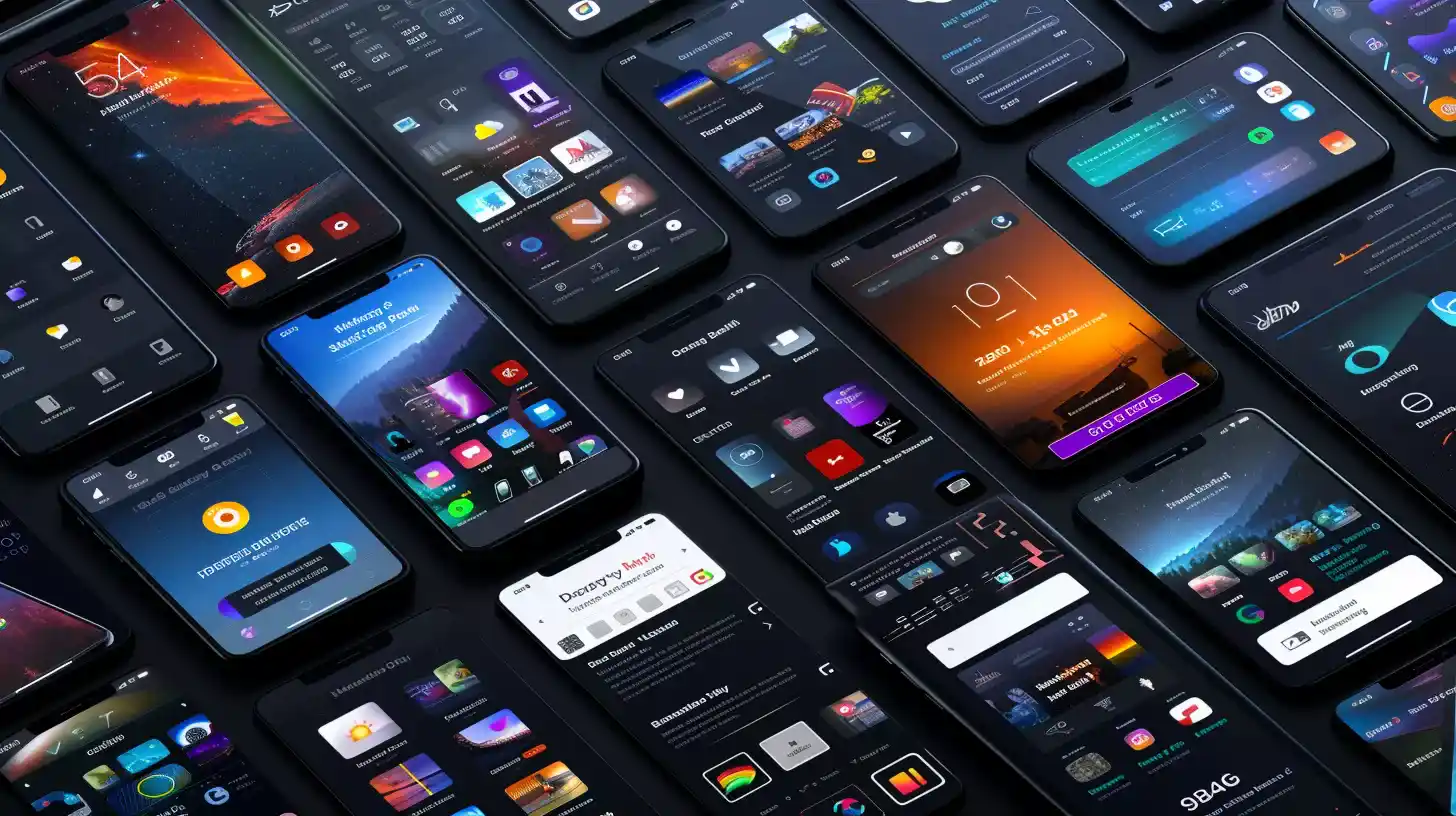Table of Contents
Have you ever imagined making your mobile app? Maybe you have a brilliant idea that could solve a problem or enhance lives. Or perhaps you see a gap in the market and envision an app that fills it perfectly. Whatever your motivation, turning your app idea into a reality requires careful planning and execution. This comprehensive guide will equip you with all the knowledge you need to navigate the exciting world of mobile app software development.
Building a Strong Foundation
A unique concept that addresses a genuine need is the cornerstone of any successful mobile app. Before diving into mobile app software development, here are some crucial steps to solidify your app’s foundation:
- Identify a Problem and Offer a Solution: Think about the challenges people face in their daily lives. Can you create an app that streamlines a task, provides information, or offers entertainment in a novel way?
- Research the Market and Analyze Competition: Don’t exist in a vacuum! Conduct thorough market research to understand existing apps in your niche. Identify their strengths and weaknesses, and explore opportunities to differentiate your app and provide a superior user experience. This is a critical step in the mobile app software development process.
Defining Your App Concept: Users and Features
- Research Your Target Audience: Who are you building this app for? Understanding your target audience’s demographics, needs, and pain points is paramount. Conduct surveys, and user interviews, or analyze market research data to gain valuable insights into mobile app software development for your target users.
- Plan the Core App Features: Prioritize Functionality: Don’t overwhelm users with bells and whistles. Start by outlining the essential functionalities that deliver core value to your target audience. This is key for a successful mobile app software development project.
- Visualize the User Experience: Sketch mockups and wireframes to visualize the user interface (UI) and user experience (UX) of your app. Consider how users will navigate the app and ensure a smooth, intuitive flow.
Security and Compliance in Mobile App Software Development
Data security and privacy are of utmost importance in the development of mobile applications. You, as the app developer, have a responsibility to safeguard user information and ensure their privacy. Here is a more in-depth look at what you should take into account:

- Data Protection:
- Identify the Data You Collect: The first step is understanding what data your app collects from users. This could include anything from basic contact information like email addresses to more sensitive data like financial details or health information. The type of data collected will determine the level of security measures you need to implement.
- Secure Data Storage: Once you’ve identified the data you collect, you need to ensure it’s stored securely. This involves encryption, both at rest (on servers) and in transit (when being transferred). Encryption scrambles the data so that even if someone were to intercept it, they couldn’t understand it.
- Access Controls: Limit access to user data to only those who need it to perform their job functions within the app. Implement strong authentication protocols like password requirements and multi-factor authentication to prevent unauthorized access.
- Data Retention Policy: Determine how long you will retain user data and establish a clear process for user deletion requests. Don’t store data longer than necessary.
- Platform Guidelines:
- App Store and Play Store Policies: Both the Apple App Store and Google Play Store have strict guidelines and policies regarding data security and user privacy. These guidelines outline what data you can collect, how you must store it, and how you must obtain user consent. Familiarize yourself with these guidelines thoroughly before developing your app to ensure compliance and avoid app store rejection.
- Privacy Policy: Your app should have a clear and concise privacy policy that explains what data you collect, how you use it, and how you share it (if applicable). The privacy policy should also outline user rights regarding their data, such as the ability to access, correct, or delete their information.
By following these data protection best practices and adhering to platform guidelines, you can build trust with your users and ensure your mobile app software development process is secure and responsible. Remember, data security is an ongoing process, so stay informed about the latest security threats and update your app’s security measures accordingly.
Choosing a Mobile App Development Approach
There are three main approaches to consider when building your mobile app:
- Learn to Code the App Yourself:
- Advantages: This approach grants you complete control over the mobile app software development process.
- Considerations: It requires significant time investment to learn the necessary programming languages and frameworks (e.g., Swift for iOS, Java/Kotlin for Android). This path is most suitable for those with a strong technical background and ample time to dedicate to learning mobile app software development.
- Hire a Professional Mobile App Developer:
- Advantages: Partnering with a professional developer leverages their expertise and experience, ensuring a high-quality app within a defined timeframe.
- Considerations: Hiring a developer comes with a cost. Carefully vet potential developers, considering their experience, portfolio, and communication style. Establish clear milestones, timelines, and communication protocols to ensure a smooth working relationship throughout the mobile app software development process.
Boost your online visibility with our advanced mobile app development solutions. Our team of experts specializes in crafting exceptional Android and iOS applications, tailored to meet the unique needs of your business. Leveraging the latest technologies, we deliver top-tier mobile solutions that ensure seamless user experiences and drive engagement. Partner with us to transform your ideas into reality and propel your brand to new heights in the mobile domain.
- Use a No-Code App Builder Platform:
- Advantages: No-code platforms offer a user-friendly interface with drag-and-drop functionalities, allowing you to build basic apps without coding knowledge.
- Considerations: While convenient, no-code platforms may limit customization options and may not be suitable for complex app functionalities. Evaluate the features, pricing plans, and publishing processes offered by different no-code platforms before choosing the one that best suits your needs for mobile app software development.
Here are some examples of No-Code App Builder Platforms, along with their strengths and considerations to help you decide if they’re right for your mobile app development project:
1. Bubble.io:
- Strengths:
- Flexible and versatile platform for building a wide range of web and mobile apps.
- Offers a large library of pre-built elements and plugins for various functionalities.
- Allows for complex data structures and workflows.
- Considerations:
- It takes time to learn how to use all the features effectively.
- Pricing can become expensive for complex apps and high traffic volumes.
2. Adalo:
- Strengths:
- User-friendly interface with a focus on mobile app development.
- Offers features specifically designed for native mobile app experiences.
- Relatively easy to learn and navigate, even for beginners.
- Considerations:
- Not as many customization choices as on other platforms.
- Smaller selection of pre-built elements and functionalities.
3. Glide:
- Strengths:
- Extremely user-friendly with a focus on building data-driven apps.
- Integrates smoothly with Google Sheets for managing data.
- Great for creating simple mobile apps quickly and efficiently.
- Considerations:
- Limited design flexibility and may not be suitable for complex app functionalities.
- Apps are primarily web apps and may not have all the features of native mobile apps.
4. Wix App Builder:
- Strengths:
- Integrates well with other Wix services, making it easy to build apps that complement existing websites.
- User-friendly interface with drag-and-drop functionality.
- Offers a variety of app templates to get you started quickly.
- Considerations:
- Fewer customization choices when compared to certain other platforms.
- Apps are primarily web apps and may not have all the features of native mobile apps.
5. Thunkable:
- Strengths:
- Caters specifically to mobile app development, offering features for both native and progressive web apps (PWAs).
- Integrates with popular development tools like Android Studio and Xcode.
- Good option for those wanting to build more complex mobile apps without extensive coding.
- Considerations:
- Steeper learning curve compared to some beginner-friendly platforms.
- Free plan has limitations on features and functionalities.
By considering these examples and their strengths and limitations, you can make an informed decision on whether a no-code app builder platform is the right fit for your mobile app development project. Remember, no-code platforms are great for building basic to moderately complex apps, but for highly customized or feature-rich apps, you might need to consider other approaches like hiring a mobile app developer.
Launching and Maintaining Your App

Once your app is developed, it’s time to launch it to the world! Here’s what you need to do in the mobile app software development process:
- Thoroughly Test the App: Conduct rigorous testing to ensure the app functions flawlessly across different devices and operating systems. Gather user feedback through beta testing to refine the user experience before the official launch.
- Submit the App for Publication: Prepare your app for submission by complying with the app store’s guidelines and providing all necessary information. Optimize the app’s title, description, and screenshots to increase discoverability and attract users to the app store.
- Continuously Update and Promote the App: The mobile app market is dynamic. Continuously monitor user reviews and feedback to identify areas for improvement in your mobile app software development. Implement new features, fix bugs, and keep the app up-to-date with the latest trends and technologies.
- Develop a Marketing Strategy: Building a great app is just half the battle. You need a well-defined marketing strategy to attract and retain users. Utilize social media marketing, influencer outreach campaigns, and app store optimization (ASO) techniques to increase visibility and downloads in the app stores.
Beyond the initial launch, here are some additional tips to ensure your mobile app thrives in the long run:
- Cultivate a User Community: Foster a community around your app by creating forums, social media groups, or hosting live chat sessions. This allows users to connect, share experiences, and provide valuable feedback for future mobile app development iterations.
- Embrace Analytics and Data-Driven Decisions: Leverage mobile app analytics tools to track user behavior, app performance, and key metrics. Analyze this data to understand user engagement patterns and identify areas for improvement. Data insights can inform future updates, marketing strategies, and overall mobile app development efforts.
- Stay Abreast of Industry Trends: The mobile app landscape is constantly evolving. Stay informed about the latest trends and technologies, such as augmented reality (AR), virtual reality (VR), and artificial intelligence (AI). Consider how these advancements can be integrated into your app to enhance functionality and user experience, keeping your app at the forefront of mobile app development.
Monetization Strategies
There are various ways to generate revenue from your mobile app, depending on your app’s purpose and target audience. Here are some common approaches:
- In-App Advertising: This involves displaying targeted advertisements within your app. You can earn revenue through a pay-per-click (PPC) model or a pay-per-impression (PPI) model. Leveraging a top PPC agency for your targeted advertisements can significantly boost your app’s visibility and user engagement. These agencies offer expert knowledge and advanced tools to optimize your ad campaigns, ensuring your budget is spent efficiently.
- Freemium Model: Offer a basic version of your app for free, with the option to upgrade to a premium version with additional features and functionalities. This can incentivize users to invest in a richer experience.
- Subscription Model: Provide access to exclusive content, features, or premium services through a recurring subscription fee.
- In-App Purchases: Sell virtual goods or services within your app, allowing users to customize their experience or progress through the app.
Conclusion
Bringing a successful mobile app to market requires careful planning, strategic execution, and ongoing maintenance. By following the steps outlined in this guide, you’ll be well-equipped to navigate the exciting world of mobile app development. Remember, the journey doesn’t end at launch. Stay committed to your vision, be responsive to user needs, and continuously iterate to stay competitive in the ever-evolving mobile landscape.
Throughout the mobile app software development process, be sure to prioritize user experience, security, and ongoing updates to ensure your app’s success. With dedication and a focus on providing value to your users, you can turn your mobile app idea into a reality and make a lasting impact in the app store.





